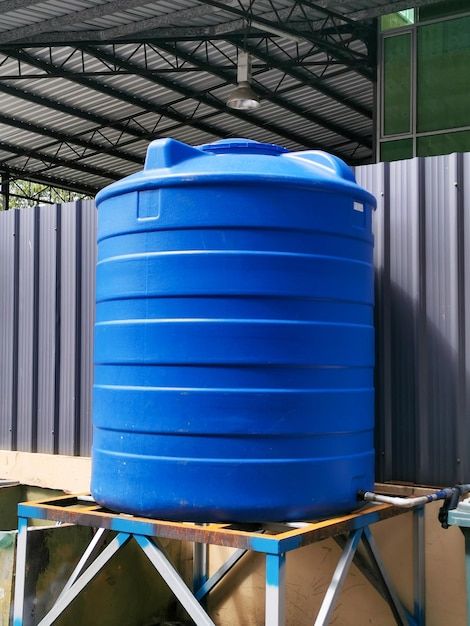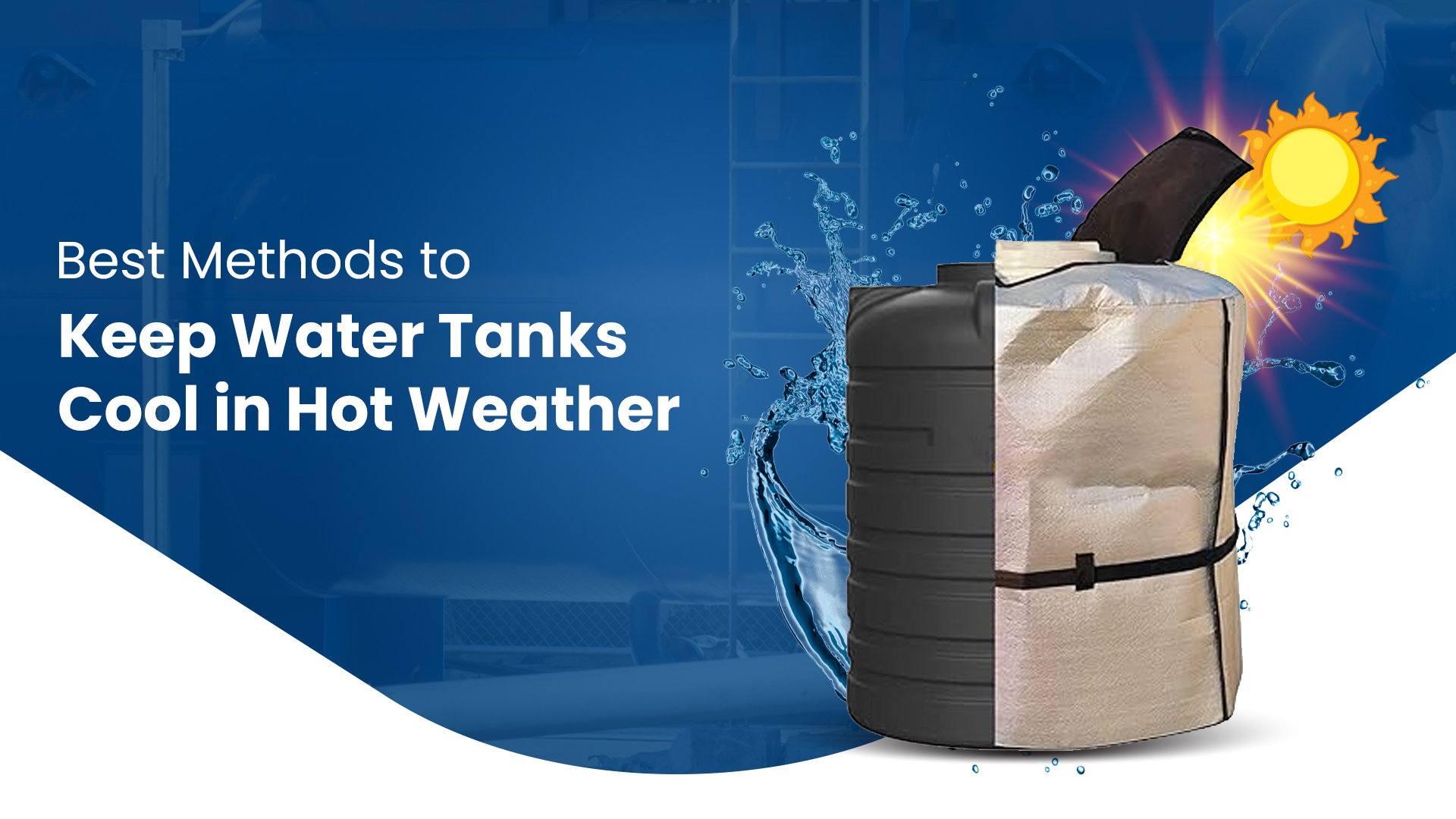When summer heat hits, your water tank works like a big heater – but you don’t want hot water sitting in there. Besides making showers less refreshing, warm tank water can cause some surprising issues. Here is what happens when your tank gets too hot:
- Bacteria grows faster in warm water
- Plastic tanks can warp or weaken over time
- The water develops a stale taste
The best part? You don’t need expensive gadgets to solve this. Just a few smart tricks can help. Following simple steps works whether you are storing water for your home, plants, or animals. Cooler water stays cleaner and safer all summer.

Source – Pinterest
1.Choose the Right Location for the Water Tank
Location matters more than you think for your water tank. When sunlight hits it directly, the tank acts like a solar heater – warming all that water inside. A simple fix? Move it to a cooler spot.
Here is how to pick the best location:
- Shade is your friend – Place the tank under a tree, awning, or roof overhang. Even partial shade helps.
- Avoid direct sunlight – South and west-facing sides get the most sun, so keep the tank away from them.
- Stay away from heat sources – Don’t install it near AC units, generators, or anything that radiates heat.
If moving the tank isn’t an option, create shade. A simple pergola or shade net can block sunlight. It will keep temperatures down. Remember, cooler surroundings mean cooler water.
2.Use Insulation Materials
Insulation works like a thermos for your water storage tank – it keeps heat out and coolness in. Even basic insulation can make a noticeable difference during hot months.
Here is how to do it right:
- Foam wraps are easy to install and effective at blocking heat
- Reflective foil sheets bounce sunlight away from the tank
- Fiberglass insulation works well for extreme heat areas
The key is covering all sides evenly. Pay extra attention to the top since that’s where most heat enters. Check insulation regularly for wear and tear – damaged sections won’t work as well.
3.Paint the Tank with Reflective Colors
The color you pick really affects temperature. Dark shades trap heat, light ones reflect it.
Best options:
- White paint reflects up to 90% of sunlight
- Silver/metallic finishes work even better
- Specialty cool roof paints designed to reject heat
Skip dark colors like blue, green, or black. If you can’t repaint, try stick-on reflective sheets instead.
4.Install a Water Tank Cover
A proper cover does double duty – it blocks sunlight and adds an extra insulation layer. Modern covers are designed specifically for water storage tanks.
What to look for:
- UV-resistant materials that won’t break down in sunlight
- Insulated designs with foam or reflective layers
- Secure fastening so it doesn’t blow away
Covers are especially helpful for tanks that can’t be moved to shade. They’re relatively inexpensive and can lower water temperature by several degrees.
5.Go Underground with Buried Tanks
If you are serious about keeping water cool, underground tanks are the ultimate solution. The earth naturally insulates, keeping water at a more stable temperature year-round.
Things to consider:
- Installation costs are higher than above-ground tanks
- Must use durable materials that won’t corrode underground
- Access points need to be designed for easy maintenance
While not practical for everyone, buried water storage tanks solve heat problems completely. They are common in areas with extreme temperatures where above-ground options just don’t cut it.
6.Keep Up with Maintenance
A clean tank stays cooler and lasts longer. Neglect leads to buildup that can actually trap heat in your water storage system.
Essential maintenance tasks:
- Drain and scrub every 6 months
- Check for algae – it grows faster in warm water
- Inspect seals and pipes for leaks that could affect temperature
Set reminders to check your tank after heat waves. That’s when problems are most likely to appear.
7.Add Cooling Accessories
Sometimes you need extra help beating the heat. These add-ons make a difference:
- Shade sails – Easy to install fabric covers that block sunlight
- Misting systems – Evaporative cooling for tanks in direct sun
- Ventilation fans – Circulate air around the tank to prevent heat buildup
The right accessory depends on your setup. For small tanks, a simple shade cloth might be enough. Larger installations often benefit from active cooling systems.
8.Upgrade to a Cooler Tank Material
Not all water storage tanks handle heat the same way. If you are replacing an old tank or installing a new one, material choice matters more than you think.
Here is how common options compare:
- Plastic (Polyethylene): Affordable but absorbs heat quickly. Go for lighter colors.
- Stainless Steel: Reflects some heat but can get warm. Needs insulation in hot climates.
- Fiberglass: Naturally more heat-resistant than plastic. Often comes in reflective finishes.
- Concrete: Thick walls keep water cooler longer but are harder to install.
In scorching climates, opt for ‘cool roof’ certified tanks. They are specially made to bounce back sunlight instead of soaking up heat.
Conclusion
You won’t need fancy gadgets to keep your water tank cool this summer. Just a few smart moves can make all the difference:
- Shade is key – Moving your tank out of direct sun is the easiest win
- Wrap it up – Insulation and reflective covers work like sunscreen for your tank
- Stay on top of maintenance – Quick checks prevent bigger problems down the road
What’s the best approach? Combine two to three approaches. A light-colored, insulated tank with a cover in a shaded area will provide the coolest water.Even implementing one of these suggestions helps.
Remember – A small time investment now means fewer headaches when the summer heat hits hardest.”
FAQs
1.How can I make my water tank cooler?
Try these simple, effective methods:
- Move it to shade – Direct sunlight heats water fastest.
- Wrap it in insulation – Foam or reflective sheets help block heat.
- Paint it white or silver – Light colors reflect sunlight instead of absorbing it.
- Add a cover – Blocks sun and keeps debris out.
2.Should I cover my water tank?
Yes! A cover helps by:
- Blocking sunlight to keep water cooler
- Preventing algae growth
- Keeping leaves, dust, and bugs out
- Choose a UV-resistant cover for long-lasting protection.
3.How do I control a hot water tank’s temperature?
For tanks with heating systems:
- Adjust the thermostat to a lower setting.
- Insulate pipes to prevent heat loss or gain.



